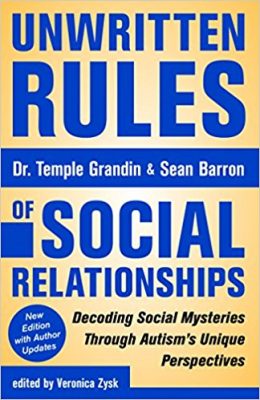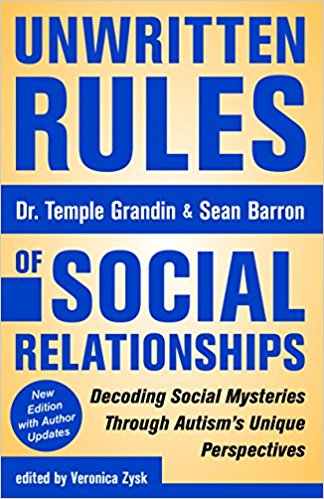 Authors: Dr. Temple Grandin and Sean Barron
Authors: Dr. Temple Grandin and Sean Barron
Publisher: Future Horizons Inc. – 426 pages
Book Review by: Sonu Chandiram
Many more books about autism spectrum disorders (ASD) have been written and published in recent years than in the past. If you do an advanced search on Amazon, you will find that out of the 20 highest-ranking books on this subject, 18 were published between 2002 and 2017, and only two appeared before that, in 1994 and 1997.
The reason for this fact is simple: much more has been researched, discovered, and published about autism and related conditions such as Asperger’s and Attention Deficit Hyperactivity Disorder (ADHD) in the last 15 years than in the years before that. And the number of popular trade books and scientific research studies is much higher after 2002 than before that.
This book is unique because it provides you both an outsider’s as well as an insider’s look on this group of basically social disorders, or being outside the norm of social behavior. I believe and I think you will agree, that when you look at something from two perspectives, you gain a greater understanding, including an extensive as well as an intensive view.
The coauthors of this unusually different book both had autism and all the fears, stresses, and ostracism that come with it. Nobody really overcomes autism totally, so I will qualify and say that “had autism” is not really a correct statement. Temple Grandin explains in her Epilogue, her own gradual process of self-improvement:
“Learning to be part of the social world around me is an ongoing process. I keep learning and doing better all the time. It’s going to be that way for most kids on the spectrum. There’s not a magic turning point after which things will become natural and effortless – it’s a process.
“Some adults seem to be searching for “a single something,” a key that will open the door to the child’s understanding of the world around him. That’s not how it happens. Fitting into society in ways that foster positive social interactions is a series of doors, each with its own key. Flexible thinking opens lots of doors, as does being able to understand another person’s perspective. They’re master keys, but there’s never going to be a single key for all doors.”
Sean Barron also relates his own story of early autism and gradual social change. He and Temple Grandin enlighten us on their personal experiences and the insight they gained, with this book of over 400 pages, Below is an outline of the contents of their work:
Introduction
- Part One: Two Perspectives on Social Thinking
- Part Two: Two Minds: Two Paths
Interlude
- Part Three: The Ten Unwritten Rules of Social Relationships
The Rules
- Rule #1: Rules Are Not Absolute; They Are Situation-Based and People-Based
- Rule #2: Not Everything That Happens is Equally Important in the Grand Scheme of Things
- Rule #3: Everyone in the World Makes Mistakes; It Doesn’t Have to Ruin Your Day
- Rule #4: Honesty Is Different Than Diplomacy
- Rule #5: Being Polite Is Appropriate in Every Situation
- Rule #6: Not Everyone Who Is Nice to Me Is My Friend
- Rule #7: People Act Differently In Public Than They Do in Private
- Rule #8: Know When You Are Turning People Off
- Rule #9: “Fitting In” Is Often Tied to Looking and Sounding Like You Fit In
- Rule #10: People Are Responsible For Their Own Behaviors
Temple’s Epilogue
Sean’s Epilogue
References
Sean Barron sums up in his Epilogue his story of not only a dismal but a dreadful future he would have when he became an adult, by writing :
“When I was twelve, I was convinced I would grow up to be a criminal and spend most of my life in prison. One of my fixations was on Charles Manson and his murderous “family’ because I felt that his fate would soon be mine, and I needed to compare myself to someone I perceived as worse off than I. Thankfully, that prediction didn’t come true.
I recommend to all people from all walks of life that they read this highly informative account of two people who have struggled with autism and have, over the years taken small steps that culminated in a transformation of their selves, and now lead productive, happy lives.
This book informs and provides you insight about autistic people and others with related disorders, especially if you have not seen them, or have very little knowledge of autism and what it is. This book is especially helpful to families wherein one member has one or the other variety of autism spectrum disorders or related conditions. It’s an eye-opener.
Authors:
Dr. Temple Grandin is author of the New York Times best-selling book Animals in Translation and the influential Thinking in Pictures. She is a Professor of Animal Science at Colorado State University, and has spearheaded reform to improve the quality of life for both animals and people with autism.
She was one of Time Magazine’s Most Influential People of 2010, and subject of the award-winning HBO biopic Temple Grandin. She has been featured on many programs including 20/20, The Today Show, 48 Hours, Fox and Friends, and NPR, and written up in national publications, including USA Today, People, and The New York Times.
Sean Barron is coauthor of There’s A Boy in There: Emerging from the Bonds of Autism. He is a distinguished speaker on his release from “the imprisonment of his mind,” as a child with autism to become a successful writer and journalist. He has appeared on Good Morning America, The Today Show, and Larry King Live, and has been highlighted in Time, People, and The New York Times.






